Hatteras 45 Convertible
1984
Best Buy
by David Pascoe
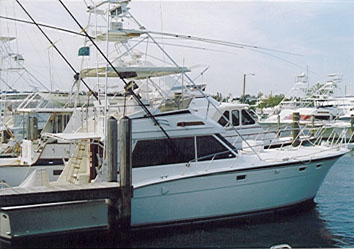
45 CONVERTIBLE Specifications
Ye old Hat. It's really a sad thing walking the docks these days and not seeing any new small Hattteraii around, and this example of an old Hat shows why. For those of you who may not have noticed, Hatteras seems to be pretty much out of the small boat business. I'm willing to venture that that is a decision they will come to regret in the not to distant future.
Now 14 years old, this boat is a great example of what a good quality product is all about. Originally a half-million dollar boat, it is selling a decade and a half later for half its original price. Not bad, not bad. And for those of you who wonder about how Hatteras stacks up against others in terms of quality, let me just say that this is not a top end yacht. Hatteras quality is just simply good, not great. Its not luxurious, not plush. Its not upholstered from one end to the other and doesn't try to wow you with all kinds of slickness. It will have absolutely zero appeal to the cocktail cruising crowd. It doesn't look like an escapee from a balloon factory or the land of no straight lines. Its just sensible design with the right materials used in the right way and with first class engineering.
Its got the right stuff. And because it is the right stuff, it lasts. You maybe heard it said that fiberglass boats can last forever? This one proves it.
Let's start with the structure. The hull above the waterline and the superstructure are balsa cored which, because of the acoustic quality of the material, gives the yacht a softer feel. Having just done an even older Hat last week without a balsa cored hull, the difference is noticeable. Underway, the sound of the water against the hull is noticeably more muted than a solid hull, and much more so than a foam cored hull.
There were no flaws in the layup and no water in the core. Everything about this one is rock solid, even when you jump down on the deck from a high dock. Stress cracks on the superstructure? Forget it, there aren't any. Nor were there any cracks along the toe rails. That's one of the premier signs of a well engineered fiberglass structure. If you're looking at a boat that's full of stress cracks all over, rest assured that the builder wasn't paying much attention to his engineering. The hull is stong, strong, strong.
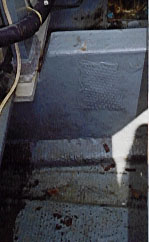
Take a look at the photo right that shows a piece of the hull framing detail. Here, a knee is added in way of the rear engine mounts to strengthen the bottom to make sure that the engines are sitting on a solid foundation. But notice too, that all the framing and stringers are on an inverted "T" section to make sure that there are no concentrated stress points where the bottom skin meets the frames. That, folks, is GOOD engineering. And what it all means is that the bottom of the boat isn't going to be flexing, eventually causing your engines to go out of alignment, eventually
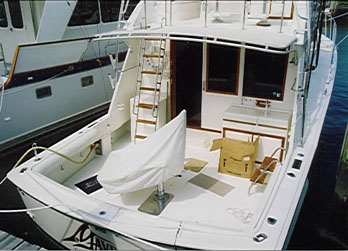
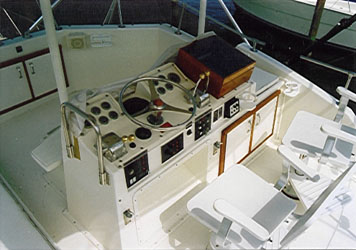
Sometime in the early 1980's Hatteras had Jack Hargrave redesign all of the earlier Hatteras hulls which were rather inefficient in terms of their shape. With a shallower keel and less deadrise aft, she planes a lot easier than, say, a 1980 model. In fact, with the little 6V92's she gets up and running right quick without digging a big hole in the water. With no GPS on board, we didn't get to clock the speed but would guess its a solid 24 knots at WOT and she'll cruise at 20-21 knots no problem at a very good attack angle. However, I should point out that this boat had no owner's stuff aboard so she was light, but she was loaded with all the fishing goodies, including a Rybo chair and 3D riggers. Knock 1-1/2 knots off if you're gonna load her up heavy. Knock another 2 knots off heading up into a 25 knot breeze with that marlin tower, but add it going downwind.
While everyone's in a rave these days about German diesels, check out all the class action lawsuits against them posted on the web. At double the cost and you'd have a hard time proving to me that they're any better. How come I see so many new engines from brand new boats with the parts scattered all over the dock? Caterpillar, MAN, MTU's -- brand spanking new and in pieces. How come? Me, I still love Detroit Diesels and the 6V92 is one of the sweetest little engines going. I look at those things and still have a hard time believing that they can turn out that much power without flying apart. But they do. They crank a ton of power out of these things and they're cheap (relatively speaking, of course) and easy to fix. Base overhaul cost is about $10,000 (minus other parts); triple that for der Deutchsmoteur. There just isn't any sweeter sound to my ears than the wonderful, deep growl of a two cycle diesel. Of course, I'm prejudiced in favor of an engine design that proved itself for 60 years.
Altogether this boat performs very well with more than adequate speed and handles rolling three footers just fine (I don't overestimate wave size). We took very little spray over the bow, so she's also fairly dry with her moderate bow flair and high freeboard.
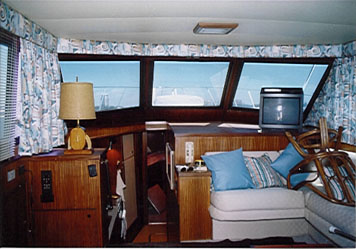
Hatteras also managed to get the weight down from the usual 1,000 lbs/ft. to a more reasonable 39,000 lbs, which is 7,000 lbs less than the 46 Bertram, which gives her a considerable edge over the Berty on speed and efficiency. Speaking of which, the engines in this boat showed no sign of ever having been overhauled. There was so much paint on them that clearly all the major parts were original, so for those of you who keep hearing horror stories about the 92 series engines, think again. Properly cared for, these are good engines that will give good service if you take care of them. That's 14 years without ever even pulling a head.
A few words about boat weight and performance. By the time you do a few thousand sea trials as I have, you develop a pretty keen sense for how a boat "feels," and whether it feels "right." There are light boats, and there are heavy boats, but somewhere in between is the ideal weight. Go out on some late model boats and you'll get a good idea of what a light boat is all about. Some of these are pretty awful. You know the expression "It bobs like a cork?" You can take it from there. Light boats have very rapid reaction times to the effect of waves, which can be rather unpleasant. Very heavy boats, of course, don't perform as well in terms of speed, and prior to Jack Hargraves redesign of the Hatteras line, most of their boats were simply too heavy to yield the kind of speeds people demand these days.
In a Hatteras, most of that weight is in the structure, so that when you go to sea in one, there is no doubt in your mind that you are on one very solid boat. Crashing into a head sea, you can feel that it is the boat, not the waves, that are winning the battle, hard as it may be. The ideal weight of a boat is the highest weight that can be achieved without undue sacrifice of performance. The heavier the boat, the less it is influenced by wave action. At 39,000 lbs. I feel that the 45C is at an ideal weight. Blasting along at 24 knots out in the stream, the mass and momentum of this yacht hurtling along pushes oncoming seas smoothly aside without undue bucking and shuddering. This is something that is very difficult to describe that, like fine wine, the ability to savor it's feel comes with experience. Its not until you've run a few poorly designed boats that you develop an appreciation of what good design is all about. Its not about increasing profits by reducing weight. And while you may save a few bucks on fuel, and gain some speed in a light boat, figure on either beating your brains out or staying home a lot more. The 45C has the feel of a much bigger boat than it really is, a real pleasure to operate.
Continuing. One machinery drawback are the Allison M20 gearboxes, which are discontinued, and you'll pay through the nose for new parts if you blow one. The good news is that there are zillions of them around that can be scavenged for used parts, so there won't be any shortage; just high prices.
Even with the generator in the engine room, there is adequate space for maintenance. The batteries are located aft under the cockpit deck and not outboard of the engines. As usual in a Convertible, the engine room is not as neat as it should be; the sea strainers are poorly placed on the outboard sides and there is no deck in the bilge so you get your feet wet and track oil all over the salon carpet. Ventillation is through very large openings through the rear bulkhead and up beside the cockpit liner, so the salt spray entering engine room problems of earlier models has been solved; this engine room runs pretty cool, and the under side of the deck is well insulated. With four turbochargers down there though, they really scream. so this is fairly noisy boat.
I think the layout of this boat is near perfect, with the cockpit, house and just about everything else apportioned just right. Even with the large Rybo chair and footrest sticking out, there is plenty of room in the cockpit for four guys and gals back there without falling over each other. Plus the bridge layout is equally good, with plenty of room behind the pedestal chairs, and adequate seating in front of the helm. To achieve this however, the helm console itself is a bit small and only the overhead electronics cabinet attached to the tower (or pipeframe top) makes for convenient mounting of your electronic goodies. Otherwise, this stuff has to go in the lower cabinets -- you know, down there around your knees where you can't reach it. But they managed to give you just enough space for a large CVS or radar, take your pick.
No itty bitty steering wheel here, she's got the full 20 incher mounted ten degrees off horizontal, which puts quite a spread between throttles and shifters, but that's a fairly minor thing. Wondering how to sit and steer? You use your feet. Its a perfectly comfortable set up. What I've always disliked about Hatteras panels is that the engine instruments are not paired, but separated in two groups, which leads to a lot visual searching around to find the gauge you're looking for. With a standard bridge ladder, there is no hole in the deck for you to accidentally fall through. Good thinking there . . . .
While she's got an in-deck bait well and a large fish box in the aft deck hatch (which is easily removed), and like most fishermen, gear storage is a bit sparse. There's good access in the lazarette to service all the stuff back there, but no storage. You can drop the fenders and stuff on top of the battery boxes in the forward hatch, but then you've got to pull them all out to check the batteries. As with most older boats, you don't have all sorts of nifty cabinets and wells built into the gunwales. HOWEVER: building all those things into the gunwales has a serious draw back! We've mentioned before just how important is a foot cove in a kitchen. Lacking the gunwale overhang, it is very awkward standing against the gunwale since your feet can't go under it. This causes you to have lean forward because you can't brace your thighs against the gunwale. If you want to see just how significant a little detail like this can be, just go aboard a newer boat where they have all that stuff built into the transom gunwale and stand there, and then try to lean over! Lacking the overhanging gunwale, its pretty easy to end up in the drink. Personally, I would not trade the ability to safely lean over the side for all those cubby holes. No way.
The interiors on these boats is a veneered plywood called afromosia; its not teak though it looks similar. It is a VERY hard veneer that holds up very well and can be easily refinished, as this boat was. Original finish is cottonseed oil, so when the finish darkens with age, you just send in a crew with cabinet scrapers and scrape all that darkened oil off and refinish it as nice as can be. Yeah, it is dark stuff that currently is out of style. But wait! Dark wood will probably be BACK in style soon enough. And while light color furnishings in a convertible is not a good idea because it gets dirty fast, I'd be inclined to do it anyway just to lighten up the interior a bit. If you like lots of wood on the interior, this one has it in spades. Its all very good quality stuff and holds up very well.
With the old style galley down arrangement, the salon is comfortably sized, and frankly I prefer it that way. The pullman style galley is large enough for some serious cooking, yet you can relax in the salon and watch TV or have a conversation without being too distracted by what's going on in the galley. Problem is, the L-shaped settee is angled in the wrong direction. Oh, well. There's a moderately sized galley sink, but room enough for something bigger. As I did long ago, more and more people are discovering that convertibles aren't just good for fishing, but make good cruising boats, too. With a galley as large as this one, and seven large storage cabinets, living and cooking aboard the 45C is plenty convenient. And while there's a big drop down into the forward spaces, the stair risers are wide and not steep. Very nice for a big up-and-down, proving again the importance of good design.
The salon has a built-in L-shaped settee which can be removed and refurnished as you wish. Otherwise, there's not much room for any other furniture unless you want to place chairs in front of the electric panel doors on the port side. As of 1984, Hatteras was still putting the panels down on the floor. Arrgghh. In later years, they moved them up high. You'll find many of these boats with the front windows blocked out and cabinets built in up under the windshield where there is a pool table-sized space. This one hadn't been altered. I have to admit, its kinda nice to be able to look forward through the windows and see where you're going. There's a good reason to have windows in front, even if they do leak. Down side is all the sunlight that comes in, heating the salon up, and there's no way you can install drapes up there and be able to reach them to close them. Some people have tried hanging them vertically, but this doesn't look so good. Best you can do is outside covers, which really aren't so bad. This one had neither and I was a bit surprised to see that the woodwork either hadn't been faded, or had been refinished very recently.
The master stateroom has the double berth in the outboard corner, a nice layout that gives you more floor space and a bit of room to move around. Yeah, its tough to make up the bed, but I'll take this trade off because I love my floor space and hate falling over things. The forward stateroom is a vee berth cabin, which is not too cool, but that's what you get for having a hull design that is sea kindly. There's no way to get a cavernous stateroom up there AND have a boat that handles a head sea well. The head with stall shower is also a bit on the smallish side, and not a place where anyone is going to spend much time in front of a mirror, but it's adequate.
While the salon has huge windows all around, the forward quarters are a bit cave-ish; the hatch covers are translucent fiberglass that casts a sickly yellowish glow down below. This would be a good place for a couple of deck prisms to lighten things up a bit. Or modify the hatches. Plus, the interior lighting is just plain lousy. Altogether, there's plenty of interior storage except for clothing lockers which are a bit meagre. Lots of drawers though.
This boat is on its second coat of paint, but the anodized window frames were not painted and are holding up well. Only one of the forward windshields was leaking a bit.
So how do I summarize the 45 Convertible? A good boat built the way a good boat should be built. A near perfect meld between strength, durability, weight and performance. This design has been perfected over a lot of years and there's little room left for improvement. Maintenance wise, its about as easy and low budget as it gets. If you're looking for a tried and true winner, this is it. A new one fitted out like this goes out the door for nearly a million bucks. You can pick one of these up for a quarter that price. You won't find another production boat any sweeter than this honey.
Posted April 28, 1998
 Visit davidpascoe.com for his power boat books
Visit davidpascoe.com for his power boat books 














David Pascoe is a second generation marine surveyor in his family who began his surveying career at age 16 as an apprentice in 1965 as the era of wooden boats was drawing to a close.
Certified by the National Association of Marine Surveyors in 1972, he has conducted over 5,000 pre purchase surveys in addition to having conducted hundreds of boating accident investigations, including fires, sinkings, hull failures and machinery failure analysis.
Over forty years of knowledge and experience are brought to bear in following books. David Pascoe is the author of:
In addition to readers in the United States, boaters and boat industry professionals worldwide from nearly 80 countries have purchased David Pascoe's books, since introduction of his first book in 2001.
In 2012, David Pascoe has retired from marine surveying business at age 65.
On November 23rd, 2018, David Pascoe has passed away at age 71.
Biography - Long version